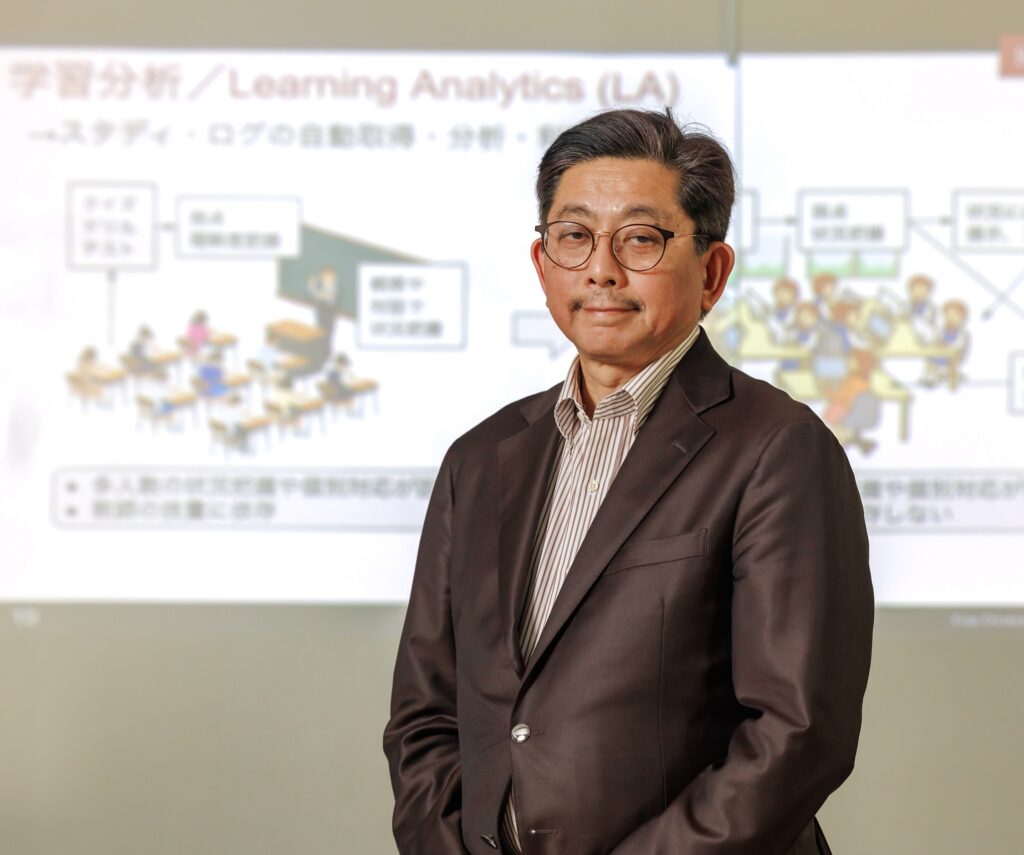
Professor Yasuhisa Tamura from the Faculty of Science and Technology specializes in research on learning technology, such as classes using computers and networks. He sheds light on research achievements and implementation of learning technology in and outside of Japan, while delving into learning analytics – an area which has recently garnered considerable attention within the field.
What are the effects of computer-based classes? How should terminals and software be designed to improve the learning results of students? These questions fall within the realm of my specialism of learning technology, an academic field of research that emerged alongside the advent of computers in the 1960s. However, it is only recently that this field has gained recognition from a wide range of industries.
The backdrop for this interest is the education ministry’s GIGA School Program, which ensures that every elementary and junior high school student has access to a computer. This has led to the prevalence of digital classrooms where students can attend classes remotely, and use computers to solve exercises or take tests.
As high schools and universities also start to adopt digital classrooms, educators, digital device providers and other stakeholders are eager to understand the insights gained from research in this area. I focus on surveying research being undertaken in this field around the world and providing information through lectures and other means.
No correlation between time spent on textbooks and students’ results

Within the field of learning technology, particular emphasis is placed on learning analytics. In traditional classrooms using paper and pencils, the students’ understanding is usually assessed through quizzes, exercises and verbal prompts such as “Do you understand this?”
On the other hand, digital classrooms can provide valuable data such as the number of times digital textbooks were referred to, the pages perused, and the places underlined. It is also possible to use cameras to gather information about students’ facial expressions and behaviors. By analyzing this data, we can begin to establish connections between learning behavior and results.
Research conducted on university students revealed that there is no correlation between the number of times digital textbooks were accessed and the students’ academic results. Other findings showed that students who look at the same slides as lecturers during classes may not necessarily do well, and that students who reviewed digital textbooks before classes obtained better results.
In addition, by examining data from class participation and report submissions, certain behavioral patterns were identified in those who drop out of university. Some universities have introduced this system to actively follow up on students who show signs of dropping out.
Moving from group lessons by teachers to classes tailored for individuals
As research in learning analytics progresses and effective learning methods become clear, we will achieve environments that are more conducive to learning; environments freed from the conventional group lessons in classrooms to learning through educational materials tailored for each person. We can expect this to result in fewer children who cannot keep up with classes.
At the same time, in-person classes will give teachers and students the opportunity to focus on aspects that are only possible in person, such as lively discussions and personalized feedback.
Currently a shortage of people wanting to be teachers, particularly at elementary school level, is also an issue. The advancement in digital technology will help reduce tasks such as marking tests, which should allow teachers to focus on teaching and increase the number of people motivated to choose teaching as a profession. I would be glad if my research contributes in some way to enhancing the learning environment.
Recently, there is a growing interest in conducting research in this field as part of final year projects, especially among students pursuing teaching degrees. My mission is also to educate and guide these young people to help them stand at the forefront of education.
The book I recommend
“Intelligence Reframed—Multiple Intelligences for the 21st Century”
by Howard E. Gardner, Basic Books 1999.

This book by a leading figure in psychology advocates the existence of Multiple Intelligences—such as kinesthetic intelligence and communication intelligence—in humans beyond generic intelligence. It is easy to see that studying alone is not enough for success in life. I recommend this book for high school students who are concerned about their futures.
-
Yasuhisa Tamura
- Professor
Department of Information and Communication Sciences
Faculty of Science and Technology
- Professor
-
Graduated from the Department of Mechanical Engineering, Faculty of Science and Technology, Sophia University, and received his Ph.D. in Engineering at the university’s Graduate School of Science and Technology. Worked at Hitachi, Ltd. and took on the positions of research assistant, lecturer, and associate professor at Sophia University’s Faculty of Science and Technology before assuming his current position in 2014.
- Department of Information and Communication Sciences
Interviewed: May 2023